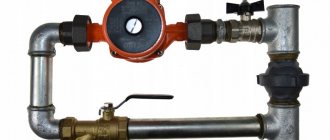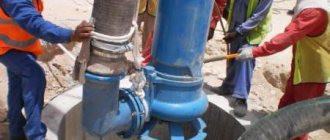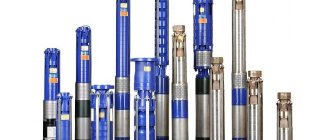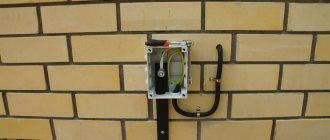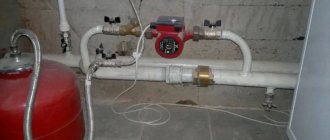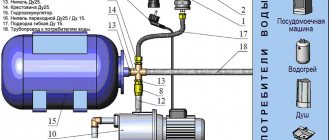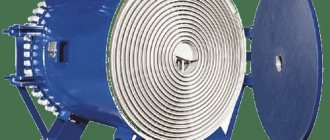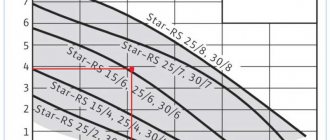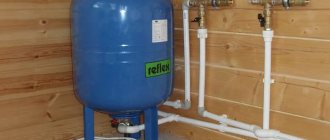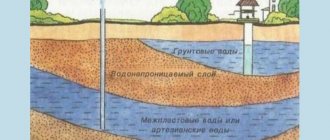Complete water supply in a private house is ensured by installing a pump in a well. Water can be taken from the mine by two devices, a surface and a submersible device.
Each option involves the use of centrifugal or vibration units. The use of a surface device is limited to the depth of the aquifer, no more than 10 meters, and a submersible pump is capable of extracting water from a depth of 60 meters.
Required materials and tools
In order to quickly install a submersible or surface apparatus in a well, install a water pipeline into the house and install automation for starting and monitoring the water supply, it is necessary to carry out preparatory work.
Purchase materials and equipment that will be needed to install the system:
- submersible or surface pump;
- set of automation equipment with hydraulic accumulator;
- pressure hose;
- distribution tee for submersible version;
- check valve;
- coarse filter for surface version;
- fitting;
- insulation;
- geotextiles;
- stainless steel cable;
- cable for supplying electricity to the pump;
- auxiliary materials for fastening and waterproofing.
To carry out installation work you will need the following tools and equipment:
- Shovels, crowbar.
- Bulgarian.
- welder.
- Electric drill.
- Screwdriver.
- Roulette.
- Set of open end and socket wrenches.
Equipment replacement
Sooner or later everything goes wrong. Therefore, it is necessary to foresee the possibility of repair and maintenance in advance. In the simplest case, the owner simply pulls out the entire structure by the halyard and performs the necessary manipulations on the surface. In stationary systems, it is desirable to have access to the connection point of the line to the flexible hose. Usually, a well of larger diameter is equipped for this purpose, allowing the master to go down there. When working, be sure to turn off the power supply.
Correct connection
Installation of the submersible apparatus and installation of the surface apparatus are carried out with a connected pressure pipe. Despite the difference in use, both hoses, pressure and suction, in their parameters must meet the requirements:
- rigidity - pressure differences should not affect the shape of the pipe;
- wear resistance - abrasive elements in water should not damage it;
- frost resistance – not to deform during operation at low temperatures;
- environmental safety - the drinking hose must be made of materials that do not emit toxic substances;
- operating temperature range from +1 °C to +40 °C.
Products made of polyvinyl chloride (metal-plastic and polypropylene) shown in advertising photos meet these requirements. Hoses are used to lift water and move it into a house or storage tank in the country, and they are fixed to the pipes of the pump, tee, or adapter using fittings.
Typical user mistakes
Out of ignorance, seemingly insignificant mistakes are often made that lead to breakdowns:
- Discrepancy between water consumption and source capabilities.
- Unreliable fastening of the device in the shaft. A break in the support cable results in unacceptable stress on the hoses and electrical cable.
- Touching the wall. The result is physical destruction of the hull.
- If the bottom is too close, solid particles are captured and parts gradually wear out.
In our article, we told you in general terms how to install a well pump in different situations, and showed connection diagrams in the most typical cases. We hope that you can solve the problem of temporary water supply at your summer cottage on your own. And to install a serious structure that supplies the house on an ongoing basis, we advise you to hire competent specialists. Professionals will help you choose the most optimal model based on your preferences and financial capabilities. To further reinforce the topic, watch the video:
How to hang and secure with your own hands
To prevent the device from ending up at the bottom during operation, it is necessary to securely fasten it with a hose to the wall of the shaft on a metal structure.
- A square-shaped frame with brackets at the corners for fixing to the wall is made from a steel corner using a welding unit.
- Two channels are welded along the diagonals of the square, and a hole is made at their intersection.
- The frame is rigidly fixed on top of the mine casing using brackets.
- A steel cable is passed through the hole in the channel, and a loop is crimped at its end to hold it on the structure.
- The pump is suspended from the safety rope and is used to remove it from the well.
Causes of system failures
Ordinary users often do not know how to properly hang, secure and connect a submersible pump in a well. This leads to premature failure of both the unit itself and communications. Excessive vibrations can also lead to accelerated siltation of the source.
Most often, the main element stops functioning for the following reasons:
- Overheating as a result of all the water being used up.
- Mechanical destruction from long-term contact with walls.
- Power failure due to improper hanging.
- Abrasive wear of parts due to the bottom being too close.
How to install a submersible machine
At least two people must take part in installing the unit into the source. Installation work of the system from the well to the house is carried out in the following sequence:
- a water supply project is being prepared, taking into account the model of the submersible unit, the automation system, and the required amount of materials for assembling the water pipeline;
- equipment, materials and necessary tools are purchased;
- between the mine and the house we dig a trench under the water pipe, taking into account the cold in your region and 50 cm wide. A layer of coarse sand (20 cm) is poured onto the bottom of the ditch, then a geotextile sheet is spread to protect the pipeline from ground and surface water with abrasive sand;
- On the prepared base, we lay high-pressure pipes made of metal-plastic or polypropylene, which are not susceptible to corrosion, in a trench, having previously been wrapped with heat-insulating material;
- cover the laid lash of the water conduit with a geotextile cloth;
- in the wall of the shaft, at the level of the bottom of the trench, we cut out a hole for the pipe into which we insert the remaining end of the water pipeline; its length should be 30–40 cm. The place where the pipeline enters the well chamber is waterproofed;
- We connect a valve to the submersible electric pump through a fitting, and a high-pressure pipe to it through a coupling. The section of the water pipeline was measured in advance taking into account the depth of the aquifer. We connect a stainless steel safety cable to a special bracket on the pump, and a cable to the electric motor. We secure the wire to the pipe with plastic clamps so that it does not sag;
- above the well we arrange a grid from a metal corner for attaching a safety rope;
- in the shaft, at the end of the water pipe, we fix a tee with a ball valve, which serves for emergency drainage of water. The outlet from the tee, directed into the well, is intended for connecting a pressure pipeline with a pump;
- manually lower the prepared whip with the pump into the source and secure the cable to the bracket. We connect the pipeline from the unit to the tee branch pipe, using plumbing paste to seal it. We lay the cable from the pump along the trench to the house;
- To supply water to the house under the foundation, we install a water pipeline with a cable into the technical room. We connect the hose to the hydraulic accumulator, and connect the cable to the automation;
- We begin commissioning work, start up the unit, and check for leaks. After the test, we dig a trench and begin operating the water supply.
To ensure trouble-free and long-term operation of the system, a PVC hose must be purchased from a specialized store.
We take into account the characteristics
In retail there are many types of these products, which differ not only in external features, but also in characteristics. You can see this in the price lists and in the photos. The price will be quite varied and will depend on the power and manufacturer. Let's briefly talk about the characteristics of pumps that you should first worry about as a buyer. Here are the most basic characteristics.
Power
This indicator is quite important. The pressure of the supplied liquid will also depend on it. So:
- Manufacturers indicate pump power in kilowatts or watts (kW or W). This indicator allows you to understand how much work this particular device can do in a unit of time. So, the greater this characteristic, the higher the pressure the pump motor will create and the greater the volume of liquid it will pump out under more difficult circumstances.
Attention: Please note that if you choose a pump that is more powerful than necessary, you will expose yourself to many troubles. For example, the pressure in the pipe will be too strong, and it will be inconvenient for you to use water. When pumping out too much water over a certain period of time, the pump will often turn off, and this, of course, will negatively affect its service life.
Performance
Pump performance is measured in liters per minute. It depends on the power of the pump, but it can show much more clearly how many liters of water the device can pump out within 1 minute.
How to choose a well pump, taking into account the required performance
When choosing a well pump, you should calculate the total water consumption at all points of use:
- These points in a private home can be kitchen taps, showers, toilet cistern, watering fixtures
- When calculating, you can take into account the following water consumption standards in a private home:
| Source | Volume |
| Wash consumption | About 60 litas/hour |
| Shower and kitchen tap consumption | About 500 litas/hour |
| Bathroom consumption | About 300 litas/hour |
| Toilet consumption | About 85 litas/hour |
| Bath consumption | About 850 litas/hour |
| Consumption for irrigation | About 1000 litas/hour |
Attention: The calculated figures do not mean that the pump will pump several cubic meters of water from the well every day - no one needs this, and besides, the well will not provide such resources.
- It is important for the pump to provide all points of its use only during specific peak hours, when family members want to wash the dishes, take a bath, and water the garden at the same time. Then, if you purchase a pump that has a lower performance than required for the point of use, various unpleasant situations may arise.
- For example, one person is in the shower, which is equipped with a water heater with running water, another person turned on the washing machine. It is clear that less water will flow into the water heater, and therefore the person taking the shower is in danger of being scalded.
Pressure
This indicator is measured in meters. It supplies water from the well and creates the necessary pressure in the above-ground part of the water supply system. So:
- To determine the pressure, it is necessary to calculate the digital height to which the water should be raised and the duration of the horizontal pipe through which it will be carried.
- The pressure when water passes through a horizontal pipe section is calculated, taking into account that the pressure decreases by one meter for every ten meter pipe section.
Calculation of pressure using an example: The pump is located in a well at a depth of 8 meters, the building is located at a distance of 20 meters from the well, the water needs to be raised to the second floor, the height of which is 4 meters. In this case, the minimum pump head is calculated as follows: 8 + 2 + 4 = 14 meters.
Connecting a hydraulic accumulator and automation
To ensure an uninterrupted water supply, it is not enough to know how to connect the device; it is important to protect the pump motor from overheating. In an autonomous water supply system, units with built-in automation are protected from voltage surges and dry operation when there is not enough water in the mine. Monitoring the operation of the pump allows you to regulate the pressure and pressure of the liquid in accordance with the parameters specified in the program.
To provide the house with water automatically, two systems are used: hydropneumatic and electronic.
1 ) In a circuit with a hydraulic accumulator, the hydraulic accumulator capacity with a control relay unit, installed in the technical room, ensures pressure regulation in the pipeline:
- The pressure in the system is monitored by a sensor. When the pressure decreases, when the pump stops sucking in water, the well becomes shallow, the electric sensor transmits a signal to the control relay, which works as a switch, and the unit stops pumping.
Selecting a device type
When collecting drinking water from a remote well, a submersible apparatus is used that is capable of lifting liquid from layers lying at a level of 60-90 m below the soil layer.
Such a pump does not need protection from precipitation and can operate silently and with high performance in any weather, including periods of frost. Installation technology, which involves completely immersing the device in water, reduces the risk of overheating of the mechanisms. The only drawback of the device is the need to lift it for maintenance.
Centrifugal
One of the popular types of submersible pumps, capable of pumping water with sand, while the concentration of the impurity should not exceed 185 g/m³. The plastic or steel pump housing houses a motor that drives a wheel with blades. Depending on the design of the blades, there are 3 types of devices: rotor, turbine and screw. When the impeller rotates, it creates a centrifugal force, under the influence of which the liquid is sucked into the internal chamber and then enters the estate's water supply system.
Such pumps are equipped with automatic equipment to protect against dry running and voltage surges. On drainage models, a float is installed to indicate a decrease in water level.
Centrifugal devices have a particularly strong impeller and are used to clean the well of debris.
Vibrating
In structures for producing water at shallow depths, vibration-type submersible pumps are used. They do not have rotating components, and the movement of fluid in the system occurs due to the influence of the electromagnetic field formed around the core with the winding.
Vibration pump.
When current is applied, the electromagnet attracts the membrane connected to the piston and well water enters the inlet chamber. As soon as the field disappears, the rod returns to its place, closing the inlet valve. At the same time, under the pressure of the piston, the liquid is pushed into the chamber behind it, so that when the magnetic field reappears, it enters the pipeline. The operation of the rod is accompanied by vibration, which can compact the soil over time and thereby reduce the flow of water.
Such models are not characterized by high performance, but they are reliable, quickly installed and do not require maintenance. It is only necessary to check the tightness of the fastenings of the body and rod, since vibration can cause the nuts to unscrew. The equipment cannot be used on floats and placed in close proximity to the bottom.
Rules for installing the surface version
Surface pumps are not often used for this type of water supply as they are only suitable for shallow hydraulic structures, up to eight meters deep.
And yet, this option has a right to exist, and its installation is no more complicated than installing submersible equipment.
Surface pumps are easier to install and cheaper than submersible models, but they are only effective for wells up to eight meters deep
Mount the device as follows:
- The surface pump is installed in a special caisson or a separate room.
- A hose of suitable length is connected to the suction pipe of the pump.
- A check valve is attached to the other end of the hose (a protective measure to prevent water from draining when the pump stops running).
- A protective strainer is installed on the valve to prevent various contaminants from entering the pump housing.
- The hose is lowered into the well.
At this point, the installation can be considered complete and a test run of the pump can be done. To install such a pump in a well, a special adapter is often used. In this case, the hose is connected to the adapter, and the adapter is connected to the pump. The rest of the installation procedure is exactly the same.
It is a little more difficult to install a surface pump equipped with a remote ejector into a well. In this case, two hoses need to be lowered into the well. In addition to the suction hose, a pressure hose is also installed. It is connected to the side fitting of the ejector using a special outlet.
In addition to the check valve and filter, an ejector must also be installed at the end of the suction hose. It should be remembered that surface pumps are very sensitive to contaminants in the water supplied from the well.
Preserving the pump for the winter
The main task is to free the pipeline system from water so that it is not torn apart by ice.
Drain taps and pipes are used for this. If the water supply system is equipped with a check valve, it must be opened to allow water to flow back into the well.
The submersible pump should be removed from the well and carried out a routine inspection: if necessary, clean and lubricate it. Many summer residents do not bother themselves with such an event, leaving the mechanism to winter in the depths.
In principle, this should not cause much harm to the equipment, but there is still a danger of it becoming silted, limed, or simply stolen by various “dashing people” who are eager for other people’s goods.
We preserve the pumping station installed on the surface in the same way. We drain the water from the working cavities of the pump itself, from the damper tank and tubes. As for whether to remove the pump from the well and take the pumping equipment with them, each owner decides for himself.
Main unit installation requirements
The station itself should also be installed according to certain rules. It is bolted to the base. The base is preferably concrete. A rigid steel frame made of rolled profiles is allowed. Its design is welded or bolted.
It is very useful to install it on a thick sheet of hard rubber - this shock absorber will reduce shock loads when turned on and reduce operating noise.
Much less often for these purposes, spring steel shock absorbers are used, placed under the base, similar to the type of fastening of the eccentric exciter of the vibration table.
But such fastening, at the slightest loosening or violation of the adjustment, can break the mounting sockets on the base of the station and create unnecessary loads on the water fittings - the vibration amplitude is too large. So the best option would be a hard rubber sheet up to 3 centimeters thick. The rigidity is approximately the same as that of a summer car tire tread.
It is important to pay due attention to the electrical part. It is mandatory to connect the station housing to the grounding loop, regardless of the choice of installation location. The use of an RCD (residual current device - the second name for this mechanism is “differential current device”) is very useful - especially if the option with a caisson is chosen or the installation was carried out directly in the well.
There is no point in overcomplicating the connection diagram. We do only what is necessary
In any case, the station must have an individual protective electrical circuit - at least a circuit breaker with an operating current slightly higher than the rated starting current of the installation.
In addition, the service life of the electrical part of the station is positively affected by the presence of stabilizers, network filters and uninterruptible power supplies. Maybe they won’t be able to have a significant impact on the engine itself, but for the electronics as part of the station’s automation unit, such an addition will be very useful.
